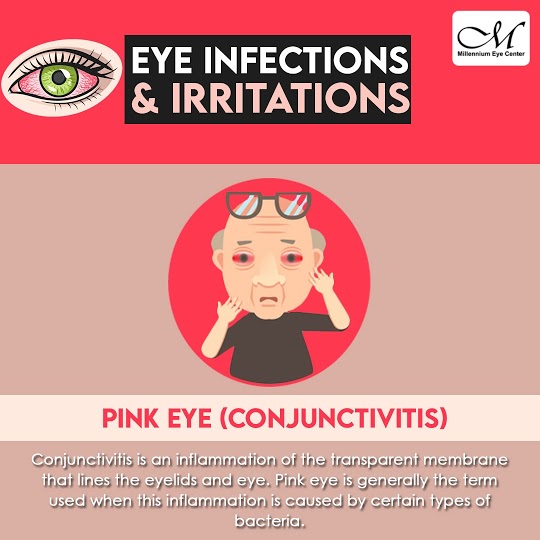Conjunctivitis or Pink Eye – Causes, Symptoms, and Treatment Options
Conjunctivitis, also known as pink eye, is the most common eye infection that affects children (as well as many adults). Learn about the causes of pink eye, symptoms and how to prevent this contagious infection from spreading.
Pink eye (conjunctivitis) is an inflammation or infection of conjunctiva — the transparent membrane that lines your eyelid and covers the white part of your eye.
When the small blood vessels in the conjunctiva get inflamed, they become more visible and cause the whites of your eyes to appear reddish or pink. Hence the name “pink eye.”
What Causes Pink Eye?
Several different things can cause pink eye, but most commonly it stems from a bacterial or viral infection, an allergic reaction, or — in infants — a blocked or unopened tear duct. Sometimes a foreign object or chemical splash in the eye can also cause conjunctivitis, so always wear protective eyewear when necessary.
Both the viral and bacterial types are very contagious and are spread through direct and indirect contact with the eye secretions of someone who is infected. Adults and children can develop both types of pink eye; however, bacterial conjunctivitis is more common in children than in adults.
What are the Symptoms of Pink Eye?
The most common symptoms of pink eye include:
- Redness in the white part (or inner eyelid) of one or both eyes
- Increased tearing
- A thick, yellow discharge (which can also be green or white) in one or both eyes
- Itchiness or burning in the eyes
- A gritty feeling in one or both eyes
- Blurred vision (due to the discharge)
If you develop allergic conjunctivitis, you may also experience sneezing and/or a nasal discharge.
When to See a Doctor
Contact your doctor if you notice any signs or symptoms that might suggest pink eye. Pink eye can be highly contagious for up to two weeks after symptoms begin but generally does not pose any serious eye health risks. Nonetheless, early diagnosis and treatment can protect the people around you from getting pink eye too.
In the case of newborns, always report pink eye to a doctor immediately, as it could lead to a vision-threatening infection if the cause is bacterial or viral (versus a blocked tear duct).
If you wear contact lenses and think you might have pink eye, stop wearing them as soon as the symptoms begin. Do not reuse contacts from the infected eye. If your symptoms persist for more than 12 to 24 hours, make an appointment with your eye doctor to make sure you do not have a more serious eye infection related to contact lens use.
How Is Pink Eye Treated?
The treatment for pink eye depends on the cause and can help ease the discomfort of irritating symptoms. Unfortunately, bacterial and viral conjunctivitis often begin in one eye and lead to infection in the other eye within a few days. Therefore, it is very important to keep the infected area clean, wash your hands regularly and keep your hands away from the uninfected eye.
If your infection is bacterial, your doctor will probably prescribe antibiotic eye drops, ointment or pills. In children, antibiotic ointment is the preferred method as it’s easier to administer. With any medication, expect symptoms to improve within several days. Remember to follow your doctor’s instructions for application and duration of use and always wash your hands after touching the infected area.
There is no treatment for most cases of viral conjunctivitis (unless caused by the herpes virus). Instead, let the virus run its course (just like a cold) and your symptoms should clear up on their own within one to two weeks.
If the irritation is allergic conjunctivitis, your doctor may prescribe a type of eye drops designed for people with allergies. These types of medications, such as antihistamines, mast cell stabilizers, decongestants, steroids, and anti-inflammatory drops, help control allergic reactions and inflammation. You may also reduce the severity of your allergic conjunctivitis symptoms by avoiding whatever causes your allergies when possible.
Other serious eye conditions can cause eye redness. Typically, these conditions also cause pain and/or blurred vision. If you are experiencing these symptoms, schedule an appointment with your local Vision Source eye doctor today.

